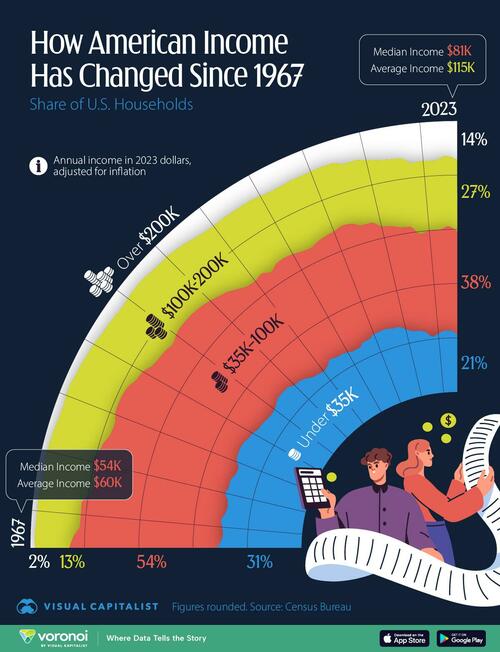
Как изменились доходы американских домохозяйств за последние 50 лет
Эта диаграмма, составленная Паллави Рао из Visual Capitalist, отслеживает долю домохозяйств США по годовому доходу с 1967 по 2023 год.

Каждый годовой доход находится в 2023 долларовС поправкой на инфляцию, но не на разницу в стоимости жизни.
Данные получены из Бюро переписи, опубликованной в 2024 году.
Американцы зарабатывают больше, чем когда-либо прежде
Доходы американских домохозяйств за последние шесть десятилетий немного выросли.
В 1967 году почти треть домохозяйств зарабатывала менее 35 000 долларов в год (с поправкой на 2023 год), а в 2023 году это упало до одной пятой.
Вот доля домохозяйств на душу населения за каждый год с 1967 года. Категории были объединены из исходного источника, и все цифры округлены. В результате проценты могут не достигать 100.
| 1967 год | 31.3 | 54.4.4 | 12,7 | 1.7 |
| 1968 год | 29,7 | 54.4.4 | 14.3 | 1.6 |
| 1969 | 29.1.1 | 52,8 | 16.2.2 | 1.9 |
| 1970 | 29,6 | 52.3 | 16.2.2 | 2 2 |
| 1971 | 30.2.2 | 51,8 | 16.1.1 | 1.9 |
| 1972 год | 29.1.1 | 50.4.4 | 18.0 | 2,5 |
| 1973 год | 28,6 | 49,4 | 19.3.3 | 2.7 |
| 1974 | 28,9 | 50.4.4 | 18.3.3 | 2.4 |
| 1975 | 30.4.4 | 50.1.1 | 17.2.2 | 2.2.2 |
| 1976 | 29,7 | 49,7 | 18.3.3 | 2.4 |
| 1977 | 29,8 | 48,7 | 18,9 | 2.6 |
| 1978 | 28,8 | 48.3 | 20.0 | 3.0 |
| 1978 | 28,8 | 48.3 | 20.0 | 3.0 |
| 1979 | 28.4.4 | 48,4 | 20.1.1 | 3.1.1 |
| 1980 | 29,8 | 48,0 | 19.4.4 | 2.7 |
| 1980 | 29,8 | 48,0 | 19.4.4 | 2.7 |
| 1980 | 29,8 | 48,0 | 19.4.4 | 2.6 |
| 1981 год | 30.4.4 | 47,9 | 19.1.1 | 2.6 |
| 1982 год | 30.6.6 | 47,6 | 18,7 | 3.1.1 |
| 1983 | 30.4.4 | 47,3 | 19.2.2 | 3.2.2 |
| 1984 | 29,5 | 46,6 | 20.4.4 | 3.6.6 |
| 1985 | 29.0 | 46,4 | 20,8 | 3.8.8 |
| 1985 | 29.0 | 46,4 | 20,8 | 3.8.8 |
| 1986 год | 28.0 | 45,5 | 22,0 | 4.5.5 |
| 1987 год | 27,8 | 45.1.1 | 22,5 | 4.7 |
| 1988 | 27.2.2 | 45.2.2 | 22,6 | 5.0 |
| 1989 год | 26,9 | 44,7 | 23.1.1 | 5.4.4 |
| 1989 год | 26,9 | 44,7 | 23.1.1 | 5.4.4 |
| 1990 год | 27.1.1 | 45,5 | 22.4.4 | 5.1.1 |
| 1991 год | 28.0 | 45.1.1 | 22,0 | 4.9 |
| 1992 год | 28,8 | 44.2.2 | 22.1. | 4.9 |
| 1993 год | 28,7 | 44.1.1 | 21.8 | 5.4.4 |
| 1994 год | 28,6 | 43,7 | 22,0 | 5.8.8 |
| 1995 | 27.4.4 | 44,0 | 22,8 | 5.8.8 |
| 1996 год | 27.2.2 | 43.2.2 | 23.4.4 | 6.3.3 |
| 1997 год | 26.3 | 43 | 23,8 | 6.9.9 |
| 1998 год | 25.1.1 | 42,6 | 24,7 | 7.7.7 |
| 1999 год | 24.6 | 41,6 | 25,5 | 8.3.3 |
| 2000 год | 24.2.2 | 41,8 | 25,5 | 8.6.6 |
| 2001 год | 24,9 | 41,9 | 24,9 | 8.4.4 |
| 2002 год | 25.2.2 | 37.1. | 25.1.1 | 8.1.1 |
| 2003 год | 25,7 | 41.0 | 24,8 | 8.4.4 |
| 2004 год | 25,6 | 41,4 | 24.6 | 8.4.4 |
| 2005 год | 25.2.2 | 41,5 | 24.6 | 8.8.8 |
| 2006 год | 24.6 | 41.3 | 24,9 | 9.2.2 |
| 2007 год | 24.6 | 40,9 | 25.3.2 | 9.1.1 |
| 2008 год | 25,9 | 40,7 | 24.6 | 8.8.8 |
| 2009 год | 26.1.1 | 41,4 | 24.0 | 8.8.8 |
| 2010 год | 27.1.1 | 40,6 | 23,7 | 8.6.6 |
| 2011 | 27.3.3 | 41,4 | 23.0 | 8.4.4 |
| 2012 год | 27.4.4 | 40,8 | 23.4.4 | 8.4.4 |
| 2013 | 26,8 | 39,6 | 23.6. | 9.8.8 |
| 2014 год | 26,8 | 39,8 | 23,7 | 9.8.8 |
| 2015 год | 25.3.2 | 39,0 | 25.2.2 | 10,5 |
| 2016 год | 24.2.2 | 39,5 | 24,9 | 11,5 |
| 2017 год | 23,8 | 38,7 | 25.4.4 | 12.1.1 |
| 2018 год | 23.0 | 39.2.2 | 25,6 | 12.3 |
| 2019 год | 21.0 | 38,0 | 26,5 | 14.6. |
| 2020 год | 21.8 | 38.1.1 | 25,8 | 14.2.2 |
| 2021 год | 22,7 | 37.1. | 25,7 | 14.4.4 |
| 2022 год | 22,7 | 38,5 | 26.0 | 12.9 |
Между тем, на другом конце спектра наблюдается рост размера скобки. В 1967 году менее 2% американских семей зарабатывали больше, чем в США. 200 000 долларов в год. В 2023 году это число возросло до 15%.
Конечно, есть увеличение рабочей силы, которое также должно учитываться. Шесть десятилетий назад только в одной трети всех американских семей работали родители. К 2009 году ситуация изменилась.
Что этот график нам не говорит
Наконец, смотреть на доходы - это только половина истории. Он не учитывает, как изменились цены на товары и услуги по сравнению с ростом доходов.
Например, дома стоили примерно в 3 раза больше среднего дохода в 1967 году, а в 2022 году — почти в 6 раз больше среднего дохода.
Тем не менее, подавляющее большинство потребительских товаров сейчас намного дешевле по сравнению с доходами из-за того, как производство переместилось в другие части мира.
Продовольствие также намного дешевле, снизившись с 15% доходов домашних хозяйств в 1967 году до примерно 7% в 2022 году, когда рекордная продовольственная инфляция подтолкнула цены вверх.
Естественно, доходы сильно различаются по всей стране. Средний доход по штату в 2024 году, чтобы увидеть, насколько.
Тайлер Дерден
Thu, 12/26/2024 - 23:00










